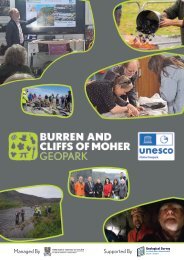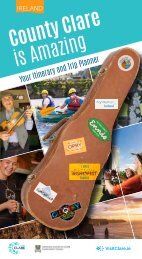Burren and Cliffs of Moher UNESCO Global Geopark - Geology
A collection of articles about the geology in the Burren and Cliffs of Moher UNESCO Global Geopark written by Dr Eamon Doyle - Geopark Geologist
A collection of articles about the geology in the Burren and Cliffs of Moher UNESCO Global Geopark written by Dr Eamon Doyle - Geopark Geologist
Create successful ePaper yourself
Turn your PDF publications into a flip-book with our unique Google optimized e-Paper software.
The significance <strong>of</strong> Slieve Elva.<br />
At 344m above sea-level, Slieve Elva (Sliabh Eilbhe) is<br />
the highest point in the <strong>Burren</strong> region. As a l<strong>and</strong>scape<br />
feature it records the past, influences the present <strong>and</strong> will<br />
contribute to the future <strong>Burren</strong> l<strong>and</strong>scape.<br />
Slieve Elva is surrounded by limestone on its western,<br />
eastern, <strong>and</strong> northern slopes but the top is not limestone,<br />
it is mostly shale with some layers <strong>of</strong> s<strong>and</strong>stone, which are<br />
largely covered by a bog. These are the same shales <strong>and</strong><br />
s<strong>and</strong>stones that stretch south to form the cliffs at Doolin<br />
<strong>and</strong> the <strong>Cliffs</strong> <strong>of</strong> <strong>Moher</strong>. The change from limestone to<br />
shale is abrupt <strong>and</strong> we know from fossils that there is a<br />
time gap (a few million years) between the last limestone<br />
being formed <strong>and</strong> the first shale being formed. We are<br />
not exactly sure what happened during that missing time<br />
period.<br />
The s<strong>and</strong>stones <strong>and</strong> shales that make the top <strong>of</strong> Slieve<br />
Elva are a just remnant <strong>of</strong> what would have covered all<br />
<strong>of</strong> the <strong>Burren</strong> millions <strong>of</strong> years ago. Erosion by rivers,<br />
<strong>and</strong> then ice, has removed these rock layers, exposing the<br />
limestone underneath. Once exposed, the limestone is<br />
then subject to the influence <strong>of</strong> rainwater which dissolves<br />
the limestone. This is demonstrated particularly well<br />
around the flanks <strong>of</strong> Slieve Elva where a large number <strong>of</strong><br />
sinkholes have developed at the contact between the shale<br />
<strong>and</strong> the exposed limestone. This has had a huge impact<br />
on the <strong>Burren</strong> over millions <strong>of</strong> years; the current <strong>Burren</strong><br />
l<strong>and</strong>scape would not have developed if the limestone was<br />
still buried under s<strong>and</strong>stone <strong>and</strong> shale.<br />
However, it is not just the rocks <strong>of</strong> Slieve Elva that are<br />
significant, the bog that caps the mountain has a very<br />
important influence on water flow in the area. The bog<br />
acts as a living water storage system that can hold water<br />
<strong>and</strong> release it slowly throughout the year. This means that<br />
the local streams always have water, although they flow<br />
underground through the limestone for some <strong>of</strong> their<br />
journey. One <strong>of</strong> those streams, the Gowlaun River at<br />
Lisdoonvarna, is fed directly by water that flows <strong>of</strong>f Slieve<br />
Elva. If you visit the Spa Wells in Lisdoonvarna after a<br />
recent rainfall event you will be able to see where the two<br />
distinctive rivers meet. The clear water <strong>of</strong> the Gowlaun<br />
River meets the dark water <strong>of</strong> the Aille.<br />
We are currently working with hydrologist Dr. Tiernan<br />
Henry <strong>of</strong> NUIG to monitor the water flow <strong>and</strong> develop a<br />
better underst<strong>and</strong>ing <strong>of</strong> how the complex river catchment<br />
works <strong>and</strong> how it will change based on climate change<br />
predictions for rainfall changes in the coming years. This<br />
ties in with the work <strong>of</strong> Lisdoonvarna citizen scientists in<br />
the Aille Engaged project who collect daily rainfall <strong>and</strong><br />
river level data.<br />
Figure caption: The clear water <strong>of</strong> the Gowlaun River (left) meets the dark water <strong>of</strong> the Aille River (right) at the Spa Wells.


















